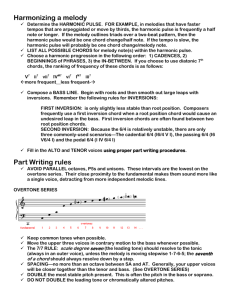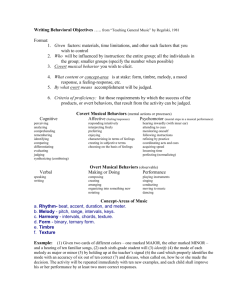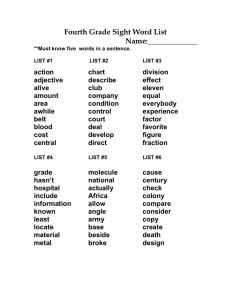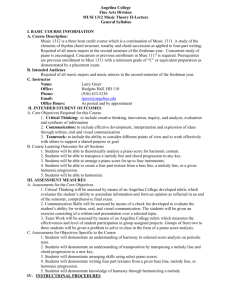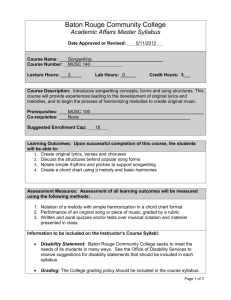Course Title: AP Music Theory District Course Number
advertisement
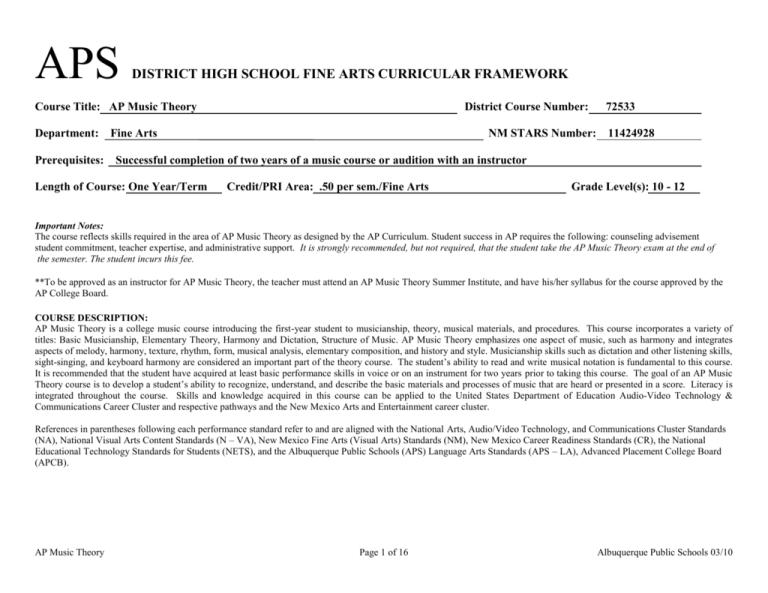
APS DISTRICT HIGH SCHOOL FINE ARTS CURRICULAR FRAMEWORK Course Title: AP Music Theory Department: Prerequisites: District Course Number: Fine Arts NM STARS Number: 72533 11424928 Successful completion of two years of a music course or audition with an instructor Length of Course: One Year/Term Credit/PRI Area: .50 per sem./Fine Arts Grade Level(s): 10 - 12 Important Notes: The course reflects skills required in the area of AP Music Theory as designed by the AP Curriculum. Student success in AP requires the following: counseling advisement student commitment, teacher expertise, and administrative support. It is strongly recommended, but not required, that the student take the AP Music Theory exam at the end of the semester. The student incurs this fee. **To be approved as an instructor for AP Music Theory, the teacher must attend an AP Music Theory Summer Institute, and have his/her syllabus for the course approved by the AP College Board. COURSE DESCRIPTION: AP Music Theory is a college music course introducing the first-year student to musicianship, theory, musical materials, and procedures. This course incorporates a variety of titles: Basic Musicianship, Elementary Theory, Harmony and Dictation, Structure of Music. AP Music Theory emphasizes one aspect of music, such as harmony and integrates aspects of melody, harmony, texture, rhythm, form, musical analysis, elementary composition, and history and style. Musicianship skills such as dictation and other listening skills, sight-singing, and keyboard harmony are considered an important part of the theory course. The student’s ability to read and write musical notation is fundamental to this course. It is recommended that the student have acquired at least basic performance skills in voice or on an instrument for two years prior to taking this course. The goal of an AP Music Theory course is to develop a student’s ability to recognize, understand, and describe the basic materials and processes of music that are heard or presented in a score. Literacy is integrated throughout the course. Skills and knowledge acquired in this course can be applied to the United States Department of Education Audio-Video Technology & Communications Career Cluster and respective pathways and the New Mexico Arts and Entertainment career cluster. References in parentheses following each performance standard refer to and are aligned with the National Arts, Audio/Video Technology, and Communications Cluster Standards (NA), National Visual Arts Content Standards (N – VA), New Mexico Fine Arts (Visual Arts) Standards (NM), New Mexico Career Readiness Standards (CR), the National Educational Technology Standards for Students (NETS), and the Albuquerque Public Schools (APS) Language Arts Standards (APS – LA), Advanced Placement College Board (APCB). AP Music Theory Page 1 of 16 Albuquerque Public Schools 03/10 STRATEGIES: The “Illustrations” column in the Program of Studies provides exemplars of the performance standards, strategies, and best practices suggested by Fine Arts teachers in the Albuquerque Public Schools (APS). ASSESSMENTS: Assessments may include: authentic and performance-based assessment, cooperative learning, teacher observations, checklists, tests and exams, formal and informal writing, small group and full class discussions, oral and multimedia presentations, projects, demonstrations, and portfolios. Assessments are based on appropriate rubrics. SUGGESTED INSTRUCTIONAL MATERIALS: Tonal Harmony, with an Introduction to Twentieth-Century Music - Stefan Kostka and Dorothy Payne. 2004. McGraw-Hill. Theory Essentials: An Integrated Approach to Harmony, Ear Training, and Keyboard Skills - Connie Mayfield 2003. Wadsworth. The Musician's Guide to Theory and Analysis Jane Piper Clendinning and Elizabeth West Marvin. 2005. W. W. Norton. Music in Theory and Practice vols. 1 and 2 – Bruce Benward, and Marilyn Saker. 2003 McGraw-Hill. Basic Ear Training Skills Robert Ottman, and Paul E. Dworak. 1991 Prentice Hall. Practical Beginning Theory: A Fundamentals Worktext - Bruce Benward, Barbara Seagrave Jackson, and Bruce R. Jackson. 2000. McGraw-Hill. Ear Training: A Technique for Listening - Bruce Benward and J. Timothy Kolosick. 2005. McGraw-Hill. Foundations of Music and Musicianship - Damschroder, David. 2006 Wadsworth. Rudiments of Music - Robert W. V. Ottman, and Frank D. Mainous. 2004 Prentice Hall. Listen and Sing: Lessons in Ear-Training and Sight-singing - David A. Damschroder, 1995. Schirmer. Anthology to Accompany the Musician's Guide to Theory and Analysis - Jane Piper Clendinning and Elizabeth West Marvin. 2005. W. W. Norton. Anthology of Music for Analysis - Stefan Kostka and Roger Graybill. 2004. Prentice Hall. SUGGESTED WEB SITES: The Canons and Fugues of J. S. Bach http://apcentral.collegeboard.com:80/Pageflows/TeachersResource/viewResourceDetail.do?resourceId= 9486 StudyStack.com Interactive Sightsinging Program The Sheet Music Archive Free Sheetmusic Library Good Ear VARIATIONS Prototype: Online Musical Scores Companion Web Site to Tonal Harmony, 5th ed. Music Paper Teaoría Musictheory.net Approved by HSCA: March 1, 2010 AP Music Theory Page 2 of 16 Albuquerque Public Schools 03/10 STRAND I: MUSICAL TERMINOLOGY CONTENT STANDARD 1: The student learns and develops the essential skills unique to musical literacy. BENCHMARK: The student applies music concepts formation about the structure, contents, and requirements of AP Music Theory that enhances the classroom learning environment. GRADE 10 - 12 PERFORMANCE STANDARDS ILLUSTRATIONS NOTE: Illustrations include suggested activities for attaining each performance standard. A check () refers to a key feature to look for while assessing student performance. 1. Exhibits the ability to properly define and apply terms and symbols for intervals, triads, seventh chords, scales, and modes (APCB – 9). 1. In a class discussion and in his/her AP Music Theory notebook the student is asked to identify pitch patterns of piece of music that is played (e.g., Beethoven’s 5th Symphony). The musical example is played twice, with a brief pause. Using a piano template or a chromatic wheel, the student: labels intervals including: numerical names, quality (e.g., perfect, major, minor, diminished and augmented) simple or compound, half step (semitone), whole step (whole tone), tritone, and inversion. determines triads including: quality (e.g., major, minor, diminished, augmented), inversions (root position, first, and second). verifies seventh chords including: quality (e.g., major seventh, dominant seventh, minor seventh, half-diminished seventh, and full-diminished seventh) and inversions (root position, first, second third). describes scales including: (e.g., Accidental, Chromatic, chromaticism, Diatonic, Key signature, Major, Minor, harmonic minor, melodic, minor (ascending/descending), natural minor, Modality, Parallel key (parallel major or minor), Pentatonic, Relative key (relative major or minor) Scale degrees, Tetrachord, Tonal, Tonality, Tonic, Whole-tone scale). analyzes the terms that describe modes: (e.g., Ionian, Dorian, Phrygian, Lydian, Mixolydian, Aeolian, and Lorcian.) 1. The student is given an example of a musical score (e.g., A Bach Choral). In a class discussion and in his/her AP Music Theory notebook, the student: describes the Rhythm, Meter, and Temporal Organization AP Music Theory Page 3 of 16 Albuquerque Public Schools 03/10 GRADE 10 - 12 PERFORMANCE STANDARDS ILLUSTRATIONS including: (e.g., Accent, agogic accent, dynamic accent, metrical accent, Anacrusis (pickup; upbeat), Asymmetrical meter, Augmentation, Bar line, Beat, Beat type, compound, simple, Changing meter (multimeter), Cross rhythm, Diminution, Dot, double dot, Dotted rhythm, Duplet, Duration, Hemiola, Irregular meter, Meter, duple, quadruple, triple, Note value, Polyrhythm, Pulse, Rhythm, Swing rhythm, Syncopation, Tempo, Tie, Time signature (meter signature), Triplet.) evaluates melodic construction and variation such as: (e.g., conjunct, disjunct, augmentation, fragmentation, inversion, literal repetition, motivic transformation, octave displacement, retro grade, rhythmic transformation, sequence, transposition, truncation, motive, theme, variation, stanza). chooses terms and symbols that describe harmonic function, including: Roman and Arabic numerals Capital Roman numerals denote major triads. Lowercase Roman numerals denote minor triads. A capital Roman numeral with a “ + ” indicates an augmented triad. A lowercase Roman numeral with a “ ø ” indicates a diminished triad. Arabic numerals or figured-bass symbols denote intervals above the bass and hence indirectly indicate chord inversion. Arabic numerals may indicate voice leading and/or nonharmonic tones. Triads 6 indicates a first inversion triad 6 4 indicates a second inversion triad Seventh Chords 7 indicates a root-position seventh chord o7 indicates a diminished (fully-diminished) seventh chord Ø7 indicates a half-diminished seventh chord 6 5 indicates first inversion 4 3 indicates second inversion AP Music Theory Page 4 of 16 Albuquerque Public Schools 03/10 GRADE 10 - 12 PERFORMANCE STANDARDS ILLUSTRATIONS 4 2 indicates third inversion Other figures 8–7 indicates melodic movement from an octave to a seventh above the bass. 2. AP Music Theory Demonstrates and creates the ability to properly define and apply terms and symbols pertaining to rhythm and meter, melodic construction and variation, harmonic function, cadences and phrase structure, texture, small forms, and musical performance (APCB – 9). Page 5 of 16 9–8, 7–6, 4–3 indicate a suspension and melodic resolution. proper vocabulary application correct numerical application knowledge of chord and interval construction organization accuracy time management mode construction description rhythms and meters melodic construction 2. Using an example of a musical score (e.g., A Mozart String Quartet), the student participates in a class discussion and in his/her AP Music Theory notebook, the student: describes cadences including: (e.g., Authentic, imperfect authentic, perfect authentic, Conclusive cadence, Deceptive, Half, Phrygian half, Inconclusive cadence, Plagal). determines the phrase structure including: (e.g., Period, antecedent, consequent, contrasting period, double period, parallel period). compares and contrasts texture including: (e.g., Alberti bass, Canon, Canonic, Chordal accompaniment, Contrapuntal, Counterpoint, imitation, imitative polyphony, nonimitative polyphony, countermelody, fugal imitation, Heterophony (heterophonic), Homophony (homophonic), chordal homophony, chordal texture (homorhythmic), melody with accompaniment, Instrumentation, brass, continuo, percussion, rhythm section, strings, timbre, woodwinds, Melody, Monophony (monophonic), Obbligato, Ostinato, Polyphony (polyphonic), Register, Solo (soli), Tessitura, Tutti, and Walking bass.) evaluates the terms and symbols that describe small forms including: (e.g., Cadence, Cadential extension, Coda, Codetta, Contour, Countermelody, Elision (phrase elision), Fragment (fragmented motive), Introduction, Jazz and pop terms (bridge, chorus, song form (AABA), turnaround, twelve-bar blues), Motive, Albuquerque Public Schools 03/10 GRADE 10 - 12 PERFORMANCE STANDARDS ILLUSTRATIONS AP Music Theory Page 6 of 16 Period, antecedent, consequent, contrasting period, double period, parallel period, Phrase group, Refrain, Small forms, binary, rounded binary, ternary,Solo (soli), Stanza, Strophic, Theme, thematic transformation, Through-composed, Tutti, Variation, Verse). classifies the terms and symbols that describe musical performance including: (e.g., Antiphonal, Articulation, arco, legato, marcato, pizzicato, slur, staccato, tenuto, Call and response, Dynamics, crescendo, diminuendo, terrace dynamics, pianissimo pp, piano p, mezzo piano mp, mezzo forte mf, forte f, fortissimo ff, Improvisation, improvisatory, Phrasing, Tempo, adagio, allegro, andante, andantino, grave, largo, lento, moderato, presto, vivace, accelerando, ritardando, ritenuto, rubato). cadenial formulas analysis ease of expression phrase structure description of texture utilization of small forms organization active participation Albuquerque Public Schools 03/10 STRAND II: NOTATIONAL SKILLS CONTENT STANDARD 2: The student acquires the ability to recognize, understand, and describe correct notational skills. BENCHMARK: The student demonstrates fluency in reading and writing musical notation to expresses ideas. GRADE 10 - 12 PERFORMANCE STANDARDS ILLUSTRATIONS 1. Identifies and notates clefs and pitches (APCB – 9). 1. Using knowledge from previous music courses, the student in his/her AP Music Theory notebook: researches and writes various clefs (e.g., treble/G clef, bass/F clef, alto, tenor, movable C clef) and how these clefs influence the name and range of pitches written on a staff. notates pitches on a grand staff. grammar and syntax variety of vocabulary accuracy organization note placement 2. Notates rhythms and meters (APCB – 9). 2. The student writes a melody of his/her choice and in his/her AP Music Theory notebook. He/She: describes the usage and notation of various time signatures including (e.g., duple, triple, quadruple, irregular, compound, simple.) notates rhythms with the correct note values as they pertain to a meter. rhythm notation rhythm matching meter organization and connection of ideas variety of vocabulary correct utilization of beats in a measure 3. Shows notations for key signatures, scales, and modes (APCB – 9). 4. Demonstrates notations for intervals and chords (APCB – 9). 5. Transposes a melody (APCB – 9). 3 – 5. After observing the teacher demonstrate formulas (e.g., W,W,H, W,W,W,H) for scales, intervals and chords, the student is asked to notate scales, intervals and chords in various keys (e.g., C major, A minor). In a timed class exercise, the student in his/her AP Music Theory notebook notates: accidentals on the staff to provide a key signature utilizing the knowledge of the circle of fifths. all major scales with or without a key signature. AP Music Theory Page 7 of 16 Albuquerque Public Schools 03/10 GRADE 10 - 12 PERFORMANCE STANDARDS ILLUSTRATIONS AP Music Theory Page 8 of 16 all natural minor, harmonic minor, and melodic minor scales with or without a key signature all modes (e.g., Ionian, Dorian, Phrygian, Lydian, Mixolydian, Aeolian, Locrian) with or without key signatures). simple and compound intervals. major, minor, augmented, and diminished triads in root position, 1 st inversion, or 2nd inversion. major, minor, dominant, half-diminished, and full-diminished seventh chords in root position, 1st inversion, 2nd inversion, and 3rd inversion. transposes a melody to any key. scale utilization proper key signature representation of intervals major and minor scale formulas major and minor chords ease of expression grammar variety of vocabulary chord inversion construction melodic transposition Albuquerque Public Schools 03/10 STRAND III: AURAL SKILLS CONTENT STANDARD 3: The student reinforces written theory with aural skills. BENCHMARK: The student applies aural components, such as listening to literature, developing melodic and harmonic dictation skills, sight-singing, and developing a creative sense for melody and progression. GRADE 10 - 12 PERFORMANCE STANDARDS ILLUSTRATIONS In an AP course in Music Theory, the student reads, notates, writes, sings, and listens to music. The development of aural skills is a primary objective of the AP Music Theory course. Throughout the course, the student listens to musical works attentively and analytically and develops his/her musical memory and ability to articulate responses to formal, stylistic, and aesthetic qualities of the works. Performance—using singing, keyboard, and student’s primary performance media—is also a part of the learning process. 1. Sight-sings major and minor modes, treble and bass clefs, diatonic and chromatic melodies, and simple and compound meters (APCB – 10). 1. The student has 75 seconds to practice and 30 seconds to sight-sing a melody. He/She hears the starting pitch at the beginning of the 75second practice period and after the end of the practice period has 30 seconds to perform the melody. sings note names (c-d-e), syllable names (do-re-mi), scale-degree numbers (1-2-3), or a neutral syllable (for example, ta-ta-ta). transposes the melody to a key that is comfortable. pitch accuracy rhythm accuracy continuity warm-ups and practicing out loud 2. Melodically dictates major and minor modes, treble and bass clefs, diatonic and chromatic melodies, and simple and compound meters (APCB – 10). 2, 4. After listening to a short melody (e.g., Twinkle, Twinkle Little Star), the student notates on the staves and provides the correct pitch and rhythm of the short melody that he/she hears making sure that any accidentals heard are appropriate for the key signature provided. Using a teacher-established pulse, the student plays each melody three times. There is a pause of 30 seconds after the first playing and a one-minute pause after each subsequent playing. The melody the student hears uses all four of the measures and contains no rests with first note of the melody provided by the teacher. correct pitch notation correct rhythmic notation AP Music Theory Page 9 of 16 Albuquerque Public Schools 03/10 GRADE 10 - 12 PERFORMANCE STANDARDS ILLUSTRATIONS 3. Harmonically dictates notation of soprano and bass lines and provides a harmonic analysis in a four-voice texture (APCB – 10). 4. Identifies notated pitch and rhythmic patterns (APCB – 10). 5. Identifies the processes and materials used in the context of music literature representing a broad spectrum of genres, media, and styles (APCB – 10). AP Music Theory Page 10 of 16 correct usage of accidentals 3, 4. The student hears a harmonic progression in four parts provided by the teacher. In each case, the progression is played four times. There is a pause of 30 seconds after the first playing and a one-minute pause after each subsequent playing. For each question, the student: notates only the soprano and bass voices. writes in the Roman and Arabic numerals that indicate the chords and their inversions. The soprano and bass notes and the Roman numeral of the first chord are given. correct pitch notation in bass and soprano voice correct rhythmic notation correct usage of accidentals appropriate Roman and Arabic numeral usage 4, 5. The student analyzes a given score with aural stimulus (e.g., Mozart: Don Giovanni). He/She participates in a class discussion and identifies and describes in his/her AP Music Theory notebook the following: melodic organization (e.g., scale-degree function of specified tones, scale types, mode, contour, sequences, motivic development), harmonic organization (e.g., chord function, inversion, quality), tonal organization (e.g., cadence types, key relationships), meter and rhythmic patterns, instrumentation (i.e., identification of timbre), texture (e.g., number and position of voices, degree of independence, presence of imitation, density), and formal procedures (e.g., phrase structure; distinctions among literal repetition. accuracy organization proper identification of key terms creativity insight comprehension Albuquerque Public Schools 03/10 STRAND IV: SCORE ANALYSIS CONTENT STANDARD 4: The student recognizes, understands, and describes the basic materials and processes of music that are heard or presented in a musical score. BENCHMARK: The student analyzes scores from a variety of genres and style periods, including popular music, jazz, and world music. GRADE 10 - 12 PERFORMANCE STANDARDS ILLUSTRATIONS The ultimate goal of an AP Music Theory course is to develop a student’s ability to recognize, understand, and describe the basic materials and processes of music that are heard or presented in a musical score. 1. Analyzes small-scale and large-scale harmonic procedures (APCB – 10). 2. Analyzes melodic organization and developmental procedures (APCB – 10). 3. Recognizes and identifies rhythmic/metric organization (APCB – 10). 4. Recognizes and identifies musical texture (APCB – 10). 5. Recognizes and identifies formal devices and/or procedures (APCB – 10). AP Music Theory Page 11 of 16 1 - 5. Using a musical score (e.g., Sor guitar quartet) with or without aural stimulus, the student writes an essay that: identifies cadence types (e.g., Authentic, imperfect authentic, perfect authentic, Conclusive cadence, Deceptive, Half, Phrygian half, Inconclusive cadence, Plagal), describes Roman-numeral and figured-bass analysis (e.g., nonharmonic tones, seventh chords, and secondary-dominant chord), identifies key centers and key relationships, recognizes modulation to closely related keys, labels scales (e.g., major, minor, pentatonic, whole-tone, modal), evaluates motivic development and relationships (e.g., inversion, retrograde, sequence, imitation), investigates meter type (e.g., duple, triple, quadruple, irregular) and beat type (e.g., simple, compound), appraises rhythmic devices and procedures (e.g., augmentation, diminution, hemiola), compares and contrasts texture types (e.g., monophony, homophony, polyphony, melody with accompaniment), recognizes textural devices (e.g., imitation, canon), determines phrase structure, recognizes phrases in combination (e.g., period, double period, phrase group), identifies small forms. harmonic procedures description of piece Albuquerque Public Schools 03/10 GRADE 10 - 12 PERFORMANCE STANDARDS ILLUSTRATIONS AP Music Theory Page 12 of 16 usage of cadences key center recognition grammatical accuracy scale identification accuracy and variety in vocabulary knowledge of common compositional practices ease of expression analysis support for argument rhythmic organization effective writing elements Albuquerque Public Schools 03/10 STRAND V: BASIC COMPOSITIONAL SKILLS CONTENT STANDARD 5: The student uses the basic rules that govern music to compose a melody and/or a multi-voiced. BENCHMARKS: A. The student harmonizes a melody with appropriate chords using good voice leading. B. The student expresses musical ideas through composition and arrangement. GRADE 10 - 12 PERFORMANCE STANDARDS ILLUSTRATIONS 1. Composes a melody (APCB - 9). 1. The student composes a melody consisting of eight measures using the techniques of the Common Practice Period (e.g., motif, conjunct/disjunct sequence). Drawing on personal experience, the student performs the melody for the class. He/She orally compares his/her melody to other melodies of the Common Practice Period. usage of conjunct and disjunct motion logical organization connection of ideas ease of expression proper identification of Common Practice Period technique sustained oral delivery effective writing elements 2. Composes two part counterpoint (APCB - 9). 2. The student composes a short piece of music written in two part counterpoint (e.g., 2-part invention) in either 1st or 2nd species adhering to the rules of 17th and 18th century counterpoint (e.g., 2-part invention in D minor). He/She performs this piece of music in a school based concert/assembly. usage of conjunct and disjunct motion logical organization connection of ideas ease of expression proper identification of Common Practice Period technique countrapuntal motion expressive achievement rhythmic accuracy note accuracy adherence to established rule AP Music Theory Page 13 of 16 Albuquerque Public Schools 03/10 GRADE 10 - 12 PERFORMANCE STANDARDS ILLUSTRATIONS 3. Composes a bass line (with chord symbols) for a given melody (APCB – 9). 3. The student composes a bass line for a given melody. He/She places the Roman numerals with inversion symbols below the bass line to indicate the harmonies implied by the soprano and bass. The student adheres to the following: bass line makes melodic sense in relation to the given soprano line. bass line and chord choices makes harmonic sense with the melody. Extension: Using his/her or someone else's melody, the student writes a bass part on the second line. He/She discusses the harmonic implications of his/her choices. The student then writes tenor and alto parts and a harmonic and melodic analysis of his/her compositions. melodic interest to the bass line. variety of motion of the bass line in relation to the soprano. quarter notes note values ranging from half notes to eighth notes. appropriate cadence at each phrase ending. application of at least two chords or two positions of the same chord per measure. 4. Composes a four-voice realization of figured-bass symbols and Roman numerals (APCB – 9). 4. The student composes the soprano, alto and tenor voices for a figured bass in four voices, following eighteenth-century voice-leading procedures (e.g., Part-Writing Rules and Procedures). Below each chord the student supplies the Roman numeral that appropriately indicates harmonic function. He/She records this information in his/her AP Music Theory notebook. range of voices part writing rules accuracy of chord spelling figured bass accuracy variety of vocabulary proper voice leading AP Music Theory Page 14 of 16 Albuquerque Public Schools 03/10 STRAND VI: CAREER READINESS CONTENT STANDARD 6: The student explores visual arts career pathways and recognizes skills necessary to seek employment in the field. BENCHMARKS: A. The student identifies education, training, and skills required for employment in the visual arts field. B. The student examines employment opportunities, workplace environments, and career growth potential for visual arts fields. GRADE 10 - 12 PERFORMANCE STANDARDS ILLUSTRATIONS 1. Describes how art provides an opportunity for lifelong learning (CR – B). 2. Formulates personal interests and aptitudes for proper course selection and career choices (CR – 1A). 3. Researches career pathways consistent with career interests, aptitudes, and abilities to meet career goals and objectives (CR – 1C; N – IX.3, 4; NA – V.2). 4. Identifies and explores career opportunities in one or more career pathways (NA – V.2; N – IX.3). 5. Practices ethical conduct, positive behaviors and personal qualities (e.g., manages time, prioritizes responsibilities) within the school, workplace, and community (CR – 4A; N – VIII.1, IX.2). AP Music Theory 6. Works cooperatively with persons from diverse backgrounds to accomplish a common goal (CR - 4B, 5C). 7. Identifies critical thinking and problem-solving skills, or identifies problems and uses critical thinking skills and team skills, to solve problems (CR – 5E). Page 15 of 16 1 – 7. The student meets the standards in this strand through a variety of activities. He/She: listens to various composers talk about their craft, how they make their living, and viable career opportunities in that field. attends music festivals discusses workplace behaviors (e.g., language, completion of work, clean up). reviews and revises his/her Next Step Plan. identifies a specific area of music interest researches possible internship opportunities and the requirements necessary for admission into the program. visits various music business (e.g.., music shops, recordings studios). researches post-secondary music programs. For each activity that the student participates in, he/she writes a reflection paper in his/her AP Music Theory notebook on what he/she heard, learned, observed, or did as part of that experience. active participation in activities successful completion of assigned duties personal reflections effective writing elements teamwork/collaboration on joint projects positive behaviors problem-solving techniques awareness development of artistic careers and options Albuquerque Public Schools 03/10 STRAND VII: LITERACY CONTENT STANDARD 7: The student communicates music theory principles through reading, writing, speaking, and research opportunities. BENCHMARK: The student demonstrates proficiency in reading comprehension, specialized vocabulary, critical thinking, and writing through a variety of classroom assignments and projects. GRADE 10 – 12 PERFORMANCE STANDARDS ILLUSTRATIONS The following standards are aligned to the APS 11 th grade Language Arts Standards unless otherwise indicated and to the National Arts, Audio/Video Technology and Communications Cluster Foundation Standards Strand #2. The student has multiple opportunities in the classroom to demonstrate literacy skills. This is made possible in almost every strand. The following are just a few instances where this is evidenced. 1. Uses critical analysis to gain meaning and synthesize ideas (APS – LA II.5). 1, 5. See Strands I and II; Strand III, the last illustration; Strands, IV, V and VI. 2. Demonstrates increased competence and fluency in using the writing process to create a final product (APS – LA III.1). 2. See Strands I and II; Strand III, the last illustration; Strand IV; the 1st and the 4th illustration in Strand V; Strand VI. 3. Demonstrates increased competence and fluency with speaking strategies (APS – LA IV.1). 3, 4, 7. See Strand I; the 4th and 5th illustration in Strand III; Strand V. 4. Participates in group discussions and/or presentations to the class (APS – LA V.2 – Gr. 9). 5. Listens to and analyzes a presentation or discussion (APS – LA V.1). 6. Synthesizes and organizes information from a variety of sources to inform and persuade an audience (APS – LA VI.9). 6. See Strands I and II; Strand III, the last illustration; Strands, IV, V and VI. 7. Develops presentations by using clear research questions and creative research strategies (e.g., field studies, experiments) (APS – LA VI.11). AP Music Theory Page 16 of 16 Albuquerque Public Schools 03/10

